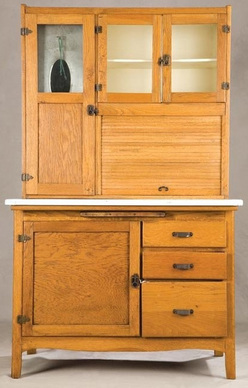Hoosier and Hoosier Cupboards
The word “Hoosier” is one of those words whose origins are lost to time. Even The Oxford English Dictionary offers no real guidance about where the word came from. What we do know is that “Hoosier” was first documented in the mid-1820s, and within a decade, it had entered general usage. John Finley, a Hoosier himself from Richmond, write a poem titled, “The Hoosier’s Nest” that was published in 1833, although his initial version uses “Hoosher.” This usage, along with many others from the period, indicate that Hoosier was most likely in oral usage for quite some time, as there appears to be no need to explain the term once it appears in print usage.
Speculation about the origins of the word began almost immediately, and a number of theories have been offered over the years. Perhaps the most widely accepted of these is from historian Jacob Piatt Dunn, Jr. Dunn pins the word’s origins on an old English dialect and the root “hoo,” which means high ground or a hill. Early usage of the word is not so specific to Indiana, but rather seems to refer to a backwoodsman or a mountain man – the kind of rough, hardy people who populated the early Appalachian frontier. For details and other theories, check out the Indiana Historical Bureau’s website and their article, “What is a Hoosier?” at http://www.in.gov/history/2612.htm.
With that out of the way, we can talk about the one of the other widespread Hoosier terms – the Hoosier cupboard. Hoosier cupboards are easily explained. By the end of the 1800s, kitchens were becoming more modern, and furniture was taking on more specific forms, moving from multipurpose forms to forms more specific to areas and purposes in the home (tables vs. dining tables, work tables, breakfast tables, etc.). As kitchens became more modern, they began to demand more specific forms, and one of the most practical examples of this was a flat-wall cupboard with a flour bin for 50 pounds of flour along one side, cupboards across the top for dry goods, a pull-out work surface – often enamel or porcelain – for kneading bread or rolling pastry crusts, all over drawers and cabinets beneath for utensils, mixing bowls and other dishes. The Hoosier Manufacturing Company was founded in 1898 (some sources say 1903), and they went on to produce cupboards or cabinets of such quality in such quantity that the word became a generic trademark – just like Kleenex or Q-Tip today. Hoosier cupboards (and Hoosier-style cupboards), models of efficiency, represent the transition between the antique wooden cupboards and the modern kitchen with its laminated countertops.

A Hoosier-style oak cabinet with flour bin and enameled work surface. (p4A item # D9807041)
-Reference note by Hollie Davis, p4A Senior Editor – June 21, 2009
Further Recommended Reading
The Hoosier Cabinet in Kitchen History by Nancy R. Hiller
